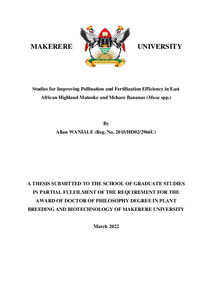| dc.description.abstract | Matooke and Mchare are two distinct subgroups of East African bananas (EABs) (Musa spp.) that are endemic to the Great Lakes region of East Africa. In this region, they are pivotal in for food and income security of more than 70 million people. However, productivity of these EABs is significantly constrained by pests and diseases that reduce the yield and directly affecting the livelihoods of banana farming communities in the region. While cultural methods of disease and pest control are widely applied, approaches that are tailored via genetic improvement are preferred because of their long-term sustainability. Conventional genetic improvement of bananas through hybridization is slow due to the complexity of factors that lead to sterility. Most of the popular banana cultivars are sterile and hardly produce seed after artificial and natural pollination. For example, in an earlier study, only 37 out of 78 Matooke cultivars were reported to set seed after artificial pollination. On the other hand, Mchare breeding only started recently in Uganda and Tanzania and their female fertility potential has not been characterized. Therefore, the main objective of this study was to contribute towards the development of effective techniques for overcoming sterility in Matooke and Mchare bananas. Specifically, the study objectives were to; (a) characterize flower opening time and behavior in selected subgroups of bananas, (b) increase in vitro and in vivo pollen germination as well as increase ovule fertilisation rates in East African Highland cooking bananas, (c) ascertain seed set patterns in East African Highland cooking bananas in relation to the bunch, fruit, and weather, (d) develop pollination techniques that increase seed set in East African Highland cooking bananas The general study approach was to reassess the factors reported to affect seed set in banana before coming up with pollination techniques for overcoming sterility. To characterize flower opening, a Nikon camera was set up to take pictures at 5-minute intervals through the flowering period. Timelapse movies were developed and played and the exact time of bract opening was recorded. To improve pollen germination and ovule fertilization, varying levels of glucose, fructose, sucrose, glucose plus fructose, and glucose plus fructose plus sucrose based pollen germination media were compared. Glucose at 30 g/L gave the highest pollen germination and was compared with diluted banana nectar. The effect of 30 g/L glucose pollen germination media on stigma receptivity was tested. To determine seed set patterns, pollinations were made on EABs using wild banana ‘Calcutta 4’ between January 2016 and January 2019. Seed set per hand was recorded as well as fruits per hand and total hands per bunch. Weather attributes were also correlated with seed set before, during, and after pollination. Principal component analysis (PCA) was used to tease out the most influential weather attribute. Development of in vivo pollination techniques involved stigma receptivity enhancement, pollinating about a day before natural flowering opening, and evening pollination. Wild fertile banana ‘Calcutta 4’ was used as the pollen source. There are differences in start of female flower opening for selected banana sub-groups (P < 0.01) with a range of 14:54 – 20:19 h and an average of 16:32 h. On the other hand, male flowers start opening later between 16:53 – 1:03 h with an average of 18:54 h. This implies that the adopted pollination time of 7:00 – 10:00 h is too late. For pollen germination, glucose at 30 g/l performed better than sucrose and diluted banana nectar (P < 0.001). When applied to stigmas, it enhanced receptivity as more pollen germinated in a shorter time. Pollen germination media also increased ovule fertilization rates. Observed seed set in hands is not equal to expected seed set in different bunch size categories (P < 0.05, 0.01, 0.001). Enhancing stigma receptivity did not change the observed seed set pattern thus, stigma receptivity is not responsible for this pattern as earlier reported. Weather is significantly associated with seed set before, during, and after pollination in EABs. Temperature was most influential with a high temperature required before and during pollination while a low temperature was required after pollination. Among new pollination techniques, the use of glucose based pollen germination media significantly increased (P < 0.05) seed set in EABs with residual fertility but not in sterile cultivars. Pollinating in the evening did not increase seed set as female and male flowers did not open in synchrony. On the other hand, forcing flowers open and pollinating about a day before natural opening did not also increase seed set likely because of immature stigma tissues. The general objective of the study was partially achieved as seed set increase was observed in the new pollination techniques of enhancing stigma receptivity. The achieved increases are still a small fraction of potential seed set which can be as high as 30,000 seeds per 100 fruits. Data from this research has laid a firm foundation for further research especially in overcoming sterility, further increase in seed set and embryo germination rates. |

